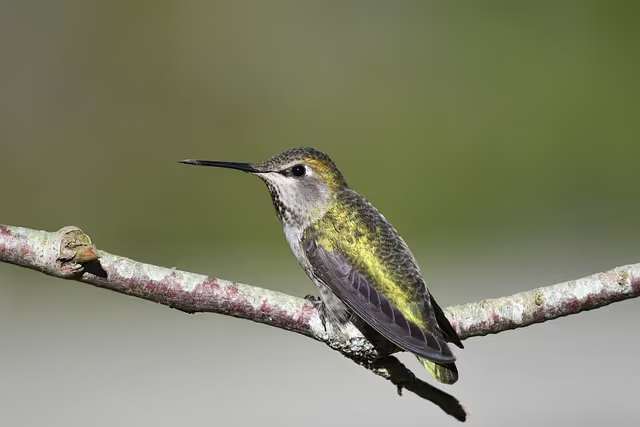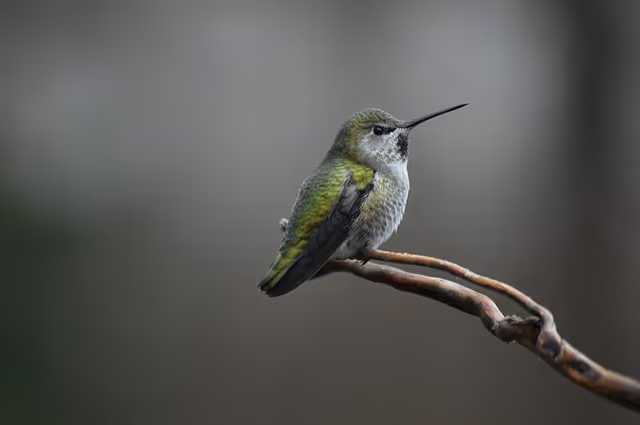Hummingbird Spotlight: Anna’s Hummingbird


Introduction
Several weeks ago, my family and I discovered that a Hummingbird had made a nest in one of the trees in our yard. We immediately began to wonder what species she belonged to, and set out to see if we could figure it out. We ultimately did, which brings us to this post here today. We determined that the Hummingbird we were watching was an Anna’s Hummingbird. Today, we are going to shine a spotlight on this most magnificent species of Hummingbird.
Size and Physical Features
By Hummingbird standards, Anna’s Hummingbirds (scientific name: Calypte anna) are medium-sized (1). However, you might have a hard time believing that when you look at just how big these birds really are. Anna’s Hummingbirds are just 3.9 inches long (10 centimeters) and have a wingspan of 4.7 inches (12 centimeters) (1). They typically weigh just 0.1 to 0.2 ounces (3 to 6 grams), and are slightly larger than Rufous Hummingbirds (1).
Anna’s Hummingbirds have shortish, straight bills and broad tails that extend beyond their wingtips when they are perched (1). They have small legs and aren’t able to walk or hop. However, they can “sort of scoot” from side-to-side while they are perched (3).
Anna's Hummingbirds typically have a body of temperature of approximately 107 degrees Fahrenheit (41.6 degrees Celsius), which is very warm. However, during colder times of the year, their body temperatures can drop to as little as 48 degrees Fahrenheit (8.8 degrees Celsius) (3). When their body temperatures get that low, they enter a state that is known as “torpor”. Torpor is a state in which the Hummingbird has no motor or mental activity and their breathing and heart rate both decline (4). When the temperature warms back up, the Hummingbirds can bounce back quickly, becoming active again in just a few minutes (3).

Image by Bryan Hanson from Pixabay
Color
Anna’s Hummingbirds mostly sport a green and gray color scheme. They don’t have any orange or rufous marks on their bodies (1). Males feature more color, as their heads and throats are covered in a patch of reddish-pink feathers that are “iridescent” in nature (1). If you happen to see a male Anna’s Hummingbird during times when there is no direct sunlight, the feathers can appear to be gray or dull brown (1). The patch of reddish-pink feathers is known as a gorget (3).
Range and Habitat
Anna’s Hummingbirds can be found up and down the west coast of the United States year-round. They have additional year-round ranges in Western Baja California and the lowland areas of Arizona. They have additional winter ranges in Eastern Baja California and in far Northern Mexico (2). An Audubon Society range map suggests that they may have an additional winter range along British Columbia’s southern inland coast (roughly from Port Hardy to Powell River) and Central Coast (roughly from an area south of Prince Rupert down to Port Hardy) (2).
Anna’s Hummingbirds live in a wide variety of habitats. They are common sights in residential yards, parks, coastal scrublands, savannahs, riverside woods, and eucalyptus groves (1). While they are more commonly found in lowland areas and on lower mountain slopes, Anna’s Hummingbirds may fly to higher mountain meadows during the summer months (1). They enjoy Hummingbird feeders and flowering plants of all types, including those that are being cultivated in gardens (1). If you have flowering plants in your yard, there is a good chance that at least one Anna’s Hummingbird will be paying you a visit.
Diet and Feeding
Anna’s Hummingbirds mostly rely on small insects and nectar from flowers to fill their stomachs. To catch small insects, they either pluck them from foliage or fly out and grab them in midair (2). When taking nectar from flowers, they extend their bills and long tongues deep into the center of the flower (2). Anna’s Hummingbirds also like to eat mixtures of sugar and water from Hummingbird feeders. They will perch or hover when using feeders (2).
Courtship and Nesting
To attract females, male Anna’s Hummingbirds perform elaborate displays. These displays usually consist of a male hovering in midair performing a “buzzy” song (2). The song may feature “explosive” squeaks or calls of “chee-chee-chee” (2). The male then flies much higher into the sky before turning around and diving steeply toward the female. When he reaches the bottom of his dive, the male will then make a loud popping sound (2). Additionally, males will buzz backwards and forwards in front of females in what are known as “short shuttling flights” (2).
Once a pair has formed, nesting season begins. This normally happens in December each year (2). The nest can be located in a variety of sites. The branches of shrubs and trees are the most common nest locations, but vines, wires, and eaves can also play host to Hummingbird nests (2). The nests are usually anywhere from four to twenty-five feet above the ground. The nest is built exclusively by the female (2). It is comprised of a compact cup that is filled with spider webs and plant fibers and lined with plant down. Feathers are sometimes added to the lining (2), presumably to provide extra warmth. The outside of the nest is camouflaged with lichens (2).
Eggs and the Young
Anna’s Hummingbirds lay two eggs at a time. The eggs are white in color (2). The incubation process is handled exclusively by the female, and runs for approximately two-three weeks (2). When the young hatch, the female takes on feeding responsibilities, sticking her bill into their mouths and regurgitating small insects. The insects may be mixed from nectar from time-to-time (2). The young typically make their first flights within three weeks of hatching (2).
References
© Ian D. Caldwell, July 2023
Touch whale bones, examine shipwreck artifacts and connect with the coast's living history.

Support our mission, get involved in educational programs, or contribute through donations and volunteering.